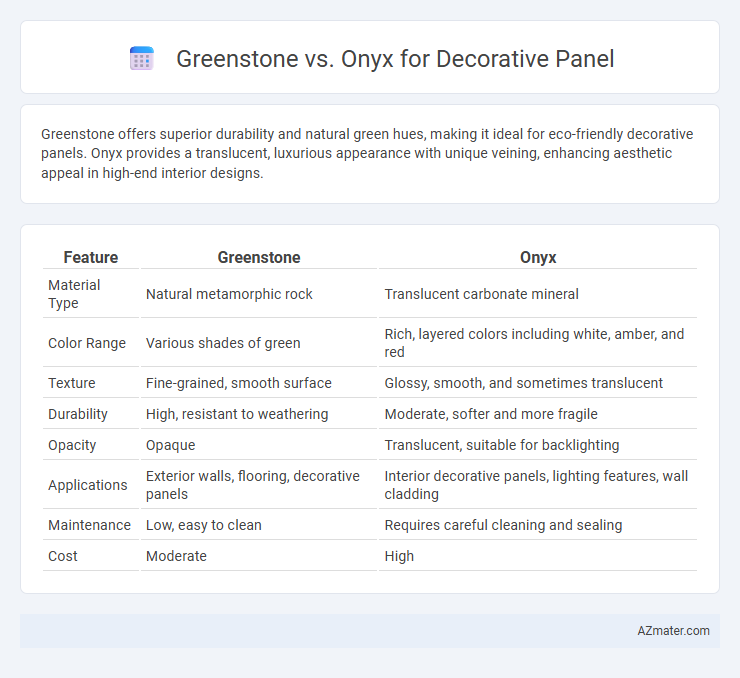Greenstone offers superior durability and natural green hues, making it ideal for eco-friendly decorative panels. Onyx provides a translucent, luxurious appearance with unique veining, enhancing aesthetic appeal in high-end interior designs.
Table of Comparison
| Feature | Greenstone | Onyx |
|---|---|---|
| Material Type | Natural metamorphic rock | Translucent carbonate mineral |
| Color Range | Various shades of green | Rich, layered colors including white, amber, and red |
| Texture | Fine-grained, smooth surface | Glossy, smooth, and sometimes translucent |
| Durability | High, resistant to weathering | Moderate, softer and more fragile |
| Opacity | Opaque | Translucent, suitable for backlighting |
| Applications | Exterior walls, flooring, decorative panels | Interior decorative panels, lighting features, wall cladding |
| Maintenance | Low, easy to clean | Requires careful cleaning and sealing |
| Cost | Moderate | High |
Introduction to Greenstone and Onyx Decorative Panels
Greenstone decorative panels are renowned for their natural, rugged texture and earth-toned hues, offering a durable and eco-friendly option for interior and exterior design. Onyx decorative panels feature a translucent, luxurious appearance with vibrant colors and intricate patterns, often enhanced by backlighting to create striking visual effects. Both materials provide unique aesthetic appeals, with Greenstone emphasizing rustic elegance and Onyx highlighting opulence and light interplay.
Origins and Geological Composition
Greenstone, a metamorphic rock originating from basaltic lava flows, is primarily composed of minerals like chlorite, epidote, and actinolite, giving it a distinctive green hue suited for decorative panels. Onyx, formed through the deposition of calcium carbonate in cold water springs or limestone caves, consists mainly of calcite and aragonite layers, presenting translucent bands ranging from white to various shades of brown. The geological differences between Greenstone's volcanic metamorphic origins and Onyx's sedimentary carbonate formation influence their texture, durability, and aesthetic appeal in interior design applications.
Aesthetic Differences: Color, Pattern, and Texture
Greenstone panels showcase a natural, earthy aesthetic with deep green hues, subtle veining, and a smooth, polished texture that adds sophistication to interiors. Onyx panels feature striking translucency, vibrant color variations from creamy whites to intense ambers, and intricate, flowing patterns that create dramatic visual interest. The contrast between Greenstone's solid, muted tones and Onyx's luminous, dynamic appearance makes each choice uniquely suited to different design themes.
Durability and Suitability for Interior Applications
Greenstone offers exceptional durability with high resistance to scratches and stains, making it ideal for high-traffic interior decorative panels. Onyx, while visually stunning with its translucent qualities, is softer and more prone to damage, requiring careful handling and maintenance in interior applications. For long-lasting interior use, Greenstone provides superior toughness and practicality, whereas Onyx is better suited for low-impact areas emphasizing aesthetics.
Maintenance Requirements and Longevity
Greenstone decorative panels require minimal maintenance due to their natural resistance to stains and weathering, making them ideal for both indoor and outdoor applications. Onyx panels, while visually striking with their translucency and unique patterns, demand more careful upkeep to prevent scratching and discoloration over time. Greenstone offers superior longevity with durability against environmental factors, whereas onyx requires more protection to maintain its aesthetic appeal and structural integrity.
Cost Comparison and Market Availability
Greenstone decorative panels typically offer a mid-range price point, balancing durability and aesthetic appeal, while Onyx panels command a premium due to their unique translucence and rarity. In terms of market availability, Greenstone panels are widely accessible from various suppliers, providing numerous options for customization and bulk purchasing. Onyx panels are more limited in supply and often sourced from specialized distributors, resulting in higher lead times and costs.
Sustainability and Environmental Impact
Greenstone panels boast high sustainability due to their use of natural minerals and low-energy manufacturing processes, reducing carbon emissions significantly compared to traditional materials. Onyx decorative panels, while visually striking, often involve energy-intensive quarrying and processing methods that contribute to higher environmental footprints. Choosing Greenstone supports eco-friendly interior solutions by minimizing waste and enhancing recyclability without sacrificing design quality.
Light Transmission and Backlighting Features
Greenstone decorative panels offer superior light transmission compared to Onyx, allowing natural and artificial light to pass through with a warm, translucent glow ideal for enhancing interior ambiance. Onyx panels excel in backlighting features due to their unique crystalline structure, creating striking visual effects with vivid contrast and depth when illuminated from behind. Both materials are favored in upscale architectural designs for their aesthetic appeal, but Greenstone is preferred for softer light diffusion while Onyx is chosen for dramatic lighting installations.
Popular Design Trends with Greenstone and Onyx
Greenstone panels exhibit a rising trend in interior design, favored for their natural, earthy hues and textured patterns that complement eco-friendly and rustic aesthetics, making them ideal for accent walls and fireplaces. Onyx panels remain popular for their translucent quality and luxurious appearance, often backlit to enhance depth and vibrant veining, fitting modern and high-end residential or commercial spaces. Both materials dominate decorative panel trends by offering unique visual appeal and versatility in contemporary design projects.
Choosing the Right Stone for Your Decorative Panels
Greenstone offers a natural, earthy aesthetic with durable mineral composition ideal for rustic or organic-themed decorative panels. Onyx features striking translucency and vibrant veining patterns, making it perfect for luxurious, high-impact interior designs that require backlighting or artistic expression. Selecting between Greenstone and Onyx depends on the balance between durability, light transmission, and the desired visual statement in your decorative application.

Infographic: Greenstone vs Onyx for Decorative Panel
 azmater.com
azmater.com